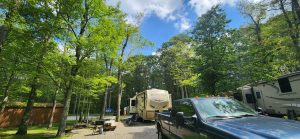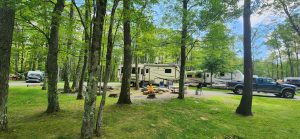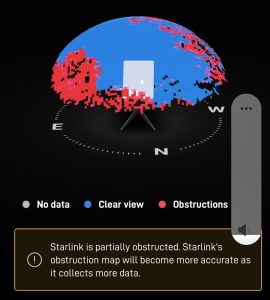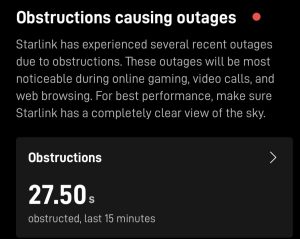Internet access on the road is a challenge. Campgrounds in National and state parks typically offer none. Even commercial campgrounds like KOA who do offer “free internet” usually warn that it is only suitable for reading emails and browsing the internet and specifically warn that it is not suitable for video chats or watching movies. Indeed, some actively block such use.
For most people, plan B is to use their mobile phones as hotspots. But that requires a signal from your mobile carrier. When camping at proximity to urban centers, that usually works. In remote areas, and in the more desirable RVing destinations, mobile cellular signals are often weak or non-existent. For example, where we currently are, my phone indicates at times 1 bar, and at time an X (no connectivity). So that is not a fail-safe option either.
Starlink satellite internet has been a game changer in providing reliable internet in the most remote areas. Thanks to Starlink, we have had fantastic internet in some of the most remote areas, such as Death Valley National Park, CA, and dry/dispersed camping on Bureau of Land Management open camping spaces near Quartzsite, AZ. As good or better than at home!!!
Basic techie parenthesis: Starlink is a Low Earth Orbit (LEO) satellite technology, which involves multiple small-sized satellites sweeping across the sky, as opposed to older geostationary satellite technology. For geostationary satellites, you need permanent direct line of sight to where the satellite is in the sky. With LEO, you will get internet while one or more of the satellites are sweeping though the portion of the sky that you can see.
This is why Starlink states that their service will work when you have an open view of the sky. And indeed, when I make a campground booking, I cut and paste this phrase in the comments section: “If possible, I prefer a site with no or low trees, so that my Starlink satellite internet antenna has a clear view of the sky”. Of course, that is not always possible, as trees and shade from the sun are desirable aspects of a well-designed campground.
Where we are camping now, we are surrounded by trees, but we still have a partial view of the sky. And its not much of a view of the sky…


Yet, as seen from this screenshot of the Starlink app on my phone, there is still an adequate view of the sky.

Claudette just wrapped up a one-hour client call. And sure enough, the zoom call froze a few times for a few seconds each time. But it’s nevertheless amazing that overall, despite high trees all around us, there was less than a total of 30 seconds of outage in a 15 minute period.

Nerdy technical parenthesis: latency and population density
Latency is a measure of radio signal travel time from the ground, up to the satellite and back. For LEO, this is significantly better than it was for geostationary satellites, which is why Starlink is very suitable for interactive communications such as video chats.
Population density impacts the quality of the internet experience, because when the satellites travel over heavily populated areas, there are more users competing for the limited total bandwidth that the satellite(s) can handle. This is why some of our best internet speeds have been “in the middle of nowhere” places such as Death Valley National Park.
Note: this is a personal blog about our RVing experience, and is not a paid promotion for Starlink service, or an endorsement of the company’s leadership.
Claudette’s Two Cents:
I just love how Bernard is so techy and makes it possible for me to continue to do what I love. And I’m eternally grateful to the people I work with to be flexible and understanding as well about my connectivity issues. I tell everyone I work with that we’ re going on a road trip together and we’ll have loads of fun.
Now I will say that I did bring my watercolor art supplies and do PLAN on painting. I’m still learning and rely on tutorials from my mentors that I watch via various videos on the internet. And we use the internet to do our research on what to see and visit at each place we go. Makes our life easier.